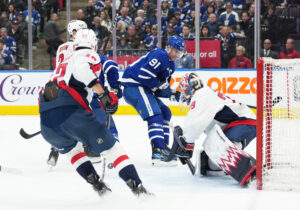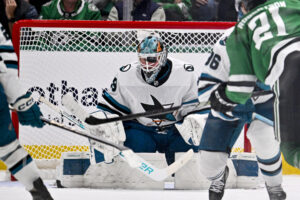The NHL and NHLPA work through different plans for finishing up the 2020-21 season. Right now the favoured choice seems to be two “hub cities” with 12 teams each. You know our opinion on that. But all the plans have one thing in common: bringing in more back-up players. In case of illness or injury, no team wants their extra players to wait in quarantine. Here are our projections for the Vancouver Canucks‘ Black Aces.
(And no whining about the playoff format here. It’s not like they haven’t changed regularly anyway!)
Who Are the Vancouver Canucks Black Aces?
We’ll start with a definition. Common history has it that when Eddie Shore went from an NHL star to AHL owner and coach, he used the term “black aces” to describe players who had fallen out of his favour and were working their way onto the team. It’s since become a popular term for those players who didn’t quite make the cut for a team. More typically it’s used for extras at international tournaments, where additional players would otherwise be an ocean away.
Teams have long brought a few players in when they entered the playoffs. Any concerns about the salary cap are gone, and having your spares taking part in practices is a practical exercise. Prospects from the system who aren’t involved in playoffs in their respective leagues can see how their parent team works. Older veterans can step in if a regular is injured or falters. It’s not unusual to see a half dozen players watching the game beyond the usual seventh defenceman/thirteenth forward.
Keeping these players handy is practical, but it’s trickier to get them into practices. The extra bodies get in the way for rushes, set plays, or any special teams work. So they usually have their own practice sessions going, learning the team’s systems just in case.
Hi, Aces!
So let’s assume that. The Canucks’ Black Aces will be six players who aren’t with the team in the regular season ready and waiting. This includes Josh Leivo and Micheal Ferland, who would be with the team if they were healthy. Those two are regular players, just injured. Even if those injuries brought Tyler Toffoli and they have been supplanted, they are established members of the Canucks.
Anyone who was with the team for the year, even if they were rarely used, is going to be exempt. This means Jordie Benn and Oscar Fantenberg are escaping our definition of a Black Ace. We’re not going to guess if Leivo or Ferland are going to be healthy enough to play, never mind where. What is certain is that every team will bring in at least a third goaltender, so we’re going to go 1-2-3. One goalie, two defensemen, three forwards.
Louis Domingue
If there’s any such thing as “lucky” timing for injuries to your star goaltender before the trade deadline is it. Louis Domingue was brought in on the trade deadline when it was decided Jacob Markstrom wouldn’t be able to get back in time to finish the regular season. The Canucks were in a tight spot, in the standings and financially, and Domingue fit. They could leave rookie Michael Dipietro in Utica and have a veteran backing up Thatcher Demko. With no season in Utica to worry about, DiPietro might join the Canucks Black Aces, but his previous NHL games have shown his time is not just yet.
It could be argued that Domingue’s last start (four goals against, .882 SV%) showed the same. But in a playoff situation, it’s more likely the team will tap the five-year veteran with 139 games under his belt.
Brogan Rafferty
Brogan Rafferty blasted out of the college ranks, leading the AHL in defenseman scoring for much of his first pro season. He finished with 45 points in 57 games, leaving little question about his offensive ability. Should the Canucks lose one of their scoring defensemen, the fast-skating Rafferty could get his chance. If, on the other hand, they need someone who plays a physical, shut-down game…
As with Domingue, one advantage he has over other potential call-ups is his age. The soon-to-be 25-year-old finished three seasons at Quinnipiac before turning pro. He certainly showed few nerves in the past year, happily leaping into the play and sending daring passes to his forwards. Rafferty is going to challenge for a spot in the Canucks lineup next year as well. This gives him a leg up on other prospects.
Olli Juolevi
A lot of Canucks fans don’t want to hear this, but Olli Juolevi is a pretty darn good prospect. Everything the Canucks liked about him in 2016 is still there. He thinks the game well, makes smart, reliable plays. He defends well, picks his spots to attack, and will be on the ice in any situation. Assuming he’s not ‘on ice’ that is.
After a few injury-plagued seasons, Juolevi finally played a mostly healthy season, playing 45 games and getting 25 points. It didn’t match his points-per-game from 2019-20, but Rafferty seized the power-play time that was previously his. Not a great loss, as that’s not where Juolevi was going to be used in Vancouver anyhow. With all the time he has lost to injuries, there is concern he is behind his expected development curve. And he is, but he remains a 22-year old prospect, despite being in the news for what feels like decades.
Zack MacEwen
The definition of a late bloomer, Zack MacEwen was signed as a free agent after his overage year in Gatineau. He was signed on as a depth player for Utica and instead has worked his way to the NHL. MacEwen played 17 games for the Canucks this year, effectively using his size and surprising scoring touch. He scored five goals in less than ten minutes per game, adding 20 minutes in penalties. As an added bonus, he’s played both wing and centre.
If he hasn’t already forced his way onto next year’s team, the RFA has at least provided GM Jim Benning with options.
Justin Bailey
Though the former second-round pick is looking like a career AHLer, Justin Bailey isn’t letting go of his NHL dreams easily. Last year was his best season since turning pro in 2015-16. He scored 28 goals and 47 points in just 53 games in Utica, earning a couple games with Vancouver. The 6’4″ doesn’t have much snarl to his game, but after watching two teams give up on him he is newly determined to grab a permanent role.
Another RFA at the end of the year, a spot on the Canucks’ Black Aces would be a reward for an excellent season in the minors. There are worse choices, and the possibility of more opportunities could help sway him to re-signing with the team.
Sven Baertschi
The $3.37 million man himself. Sven Baertschi has NHL skill, and with the salary cap being ignored, the playoffs are his opportunity for a comeback. Unfortunately, there isn’t any room for him with everyone healthy, nor is there likely to be next year. Even if the Canucks intend to showcase him, it won’t happen during the playoffs.
Baertschi played a mostly-healthy season in Utica, embracing his role as mentor and NHL veteran to the younger players. He was productive, with 46 points in 43 games. More importantly, he spent the year free of concussions or concussion-like symptoms. If the Canucks need scoring during the… well, whatever the playoffs look like, he may well draw into the lineup.
Game On!
While we likely won’t see any of the Canucks’ Black Aces in the playoffs, their job is to be ready – just in case. The rest of the league – and all of us – already has plenty of practice. And we’re all looking forward to the day the league starts up again, whatever it looks like.
Main Photo:






